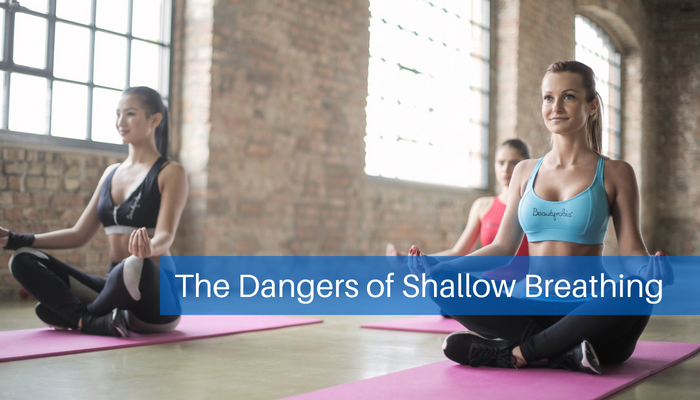
Correct breathing is underestimated, and over time, the (bad) habit poor breathing habits, combined with many hours spent hunched over a computer screen, the desire to have a trim midsection (sucking in the tummy) and the continual state of stress and hurry which many teenagers and adults experience, have all contributed to shallow breathing becoming the “norm.” It may not seem like a big deal, but you’re only filling a fraction of your lung capacity. Shallow breathing affects focus, cell metabolism, and many other functions in the body. Let’s investigate the problems with shallow breathing and how you can learn to breathe more deeply for better health through breathing exercises.
WHY DO WE BREATHE THIS WAY?
People don’t consciously think about breathing, and accept it simply as an unconscious activity, one which requires no training. Since the activity isn’t “life threatening”, many don’t understand its danger to good health. Since most adults have the misunderstanding that only carbon dioxide is exhaled, it seems sensible that any breath is a “good” breath.
When experiencing anxiety, people take rapid, shallow breaths. Even when NOT under stress, you can feel like you are hyperventilating, multiplying the succession of shallow breaths. This leads to stress, which causes shallow breathing, which increases stress, and so on, in a vicious cycle. The effect can snowball, creating tension which may lead to poor posture and exacerbating respiratory conditions like asthma and COPD.
PHYSICAL EFFECTS OF SHALLOW BREATHING
- Only breathing from top part of lungs, reduced oxygen impairs your thinking. Study by researchers at Northwestern University found that there is a connection between breathing and cognitive function, which was stronger during the inhalation phase of breathing. Shallow breathing disrupts the balance of oxygen and carbon dioxide, which keeps the right amount of oxygen coming in and equal amounts of carbon dioxide going out.
- Shallow breathing increases blood pressure and increases heart rate. Longer breaths, both inhale and exhale, slow the heart rate down and decrease blood pressure. The decreased blood pressure leads to a reduction in the stress hormone, cortisol, which is known to speed up aging.
- By breathing in this fashion, you are preventing your body from utilizing the respiratory muscles as well. Many don’t understand that you exercise your diaphragm and abdominal muscles with deep breathing. Shallow breathing often equates to reduced physical ability—you have less endurance and become winded faster.
- Shallow breathing can cause sleep issues, complicating fatigue experienced by not breathing effectively with the respiratory muscles. This leads to—or exacerbates—pain, including headaches and pain in the neck and upper back due to the disengagement of the diaphragm.
THE BENEFITS OF DEEP BREATHING
- Now that you understand some of the physical and physiological effects of shallow breathing, discover all the benefits of deep breathing, through specific deep breathing exercises and by training the body to breathe deeper naturally:
- Gain more oxygen. When you take a deep breath, you fill your lungs all the way with oxygen, and can exhale poisonous carbon dioxide. This is the reason it is important to have a longer exhale than inhale; since carbon dioxide is poisonous, it is important to get it out of the body.
- Deep breathing is a natural relaxer. By thinking about breathing, you are more in tune to your body. There is much hoopla surrounding mindful living, and too often our culture pushes us into so many activities that life becomes automated. One form of deep breathing, called pranayama or “yoga breathing,” increases the focus on the body and on the art of breathing, while reducing stress and slowing (think “calming”) the entire body down.
HOW TO REDUCE SHALLOW BREATHING WITH RESPIRATORY EXERCISES
One of the first steps in learning to reduce shallow breathing is to recognize it. Just because you are born to breathe doesn’t mean you are trained to breathe effectively. To decipher the difference between shallow and deep breathing, try this exercise:
- Lie on the floor, using your hands to feel your stomach rise and fall. Pay attention to whether your chest is rising or your diaphragm. Focus on breathing thru the lower, not the upper, torso.
- Consider the saying “Out with the old, in with the good” as you concentrate on correct form while breathing.
- Practice breathing in and out through your nose, taking long breaths.
Once you have mastered the art of deep breathing, you are ready to Improve your respiratory system’s natural ability. A respiratory training device like the PowerLung can build upon the training you have already begun, improving your breathing efficiency and increasing your physical and athletic ability. With the PowerLung, inspiratory and expiratory training are combined in one effective device. PowerLung is not simply for athletes, musicians, or those suffering from respiratory disease; it is for anyone who wants to experience the benefits of deep breathing with a well-trained, effective respiratory system.

